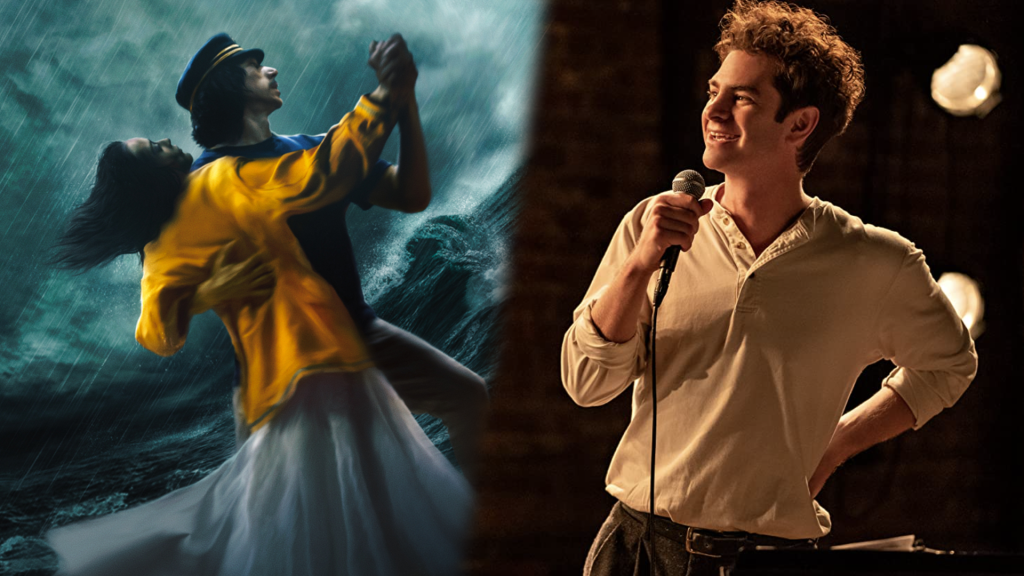Arthurian literature, some of the greatest written work of all time, has never been adapted for cinema accurately or particularly well. Why? Not that the content is particularly tricky, but it demands a studied scholar familiar enough with centuries of history, themes, and isms to translate all the richness that resides on the page beyond just story. And with the power of A24 backing him, David Lowery has finally done just that in The Green Knight.
In this adaptation of the 14th-century poem of similar name, Dev Patel takes the mantle of Sir Gawain, an aimless, indulgently worldly nephew of King Arthur who shirks his destiny of becoming a knight by drinking and philandering through his days as a noble. One day, at his uncle’s Christmas feast, the film’s eponymous figure interrupts the gathering with a proposition: for whoever strikes him, he’ll reward his prized axe. In return, a year from then, the Green Knight will return the same blow with equal might at his home, the Green Chapel. Gawain accepts the challenge and, in the spur of the moment, decapitates him.
The Knight picks his head up and leaves, earning Gawain a year of acclaim in Camelot before Arthur urges him to honor his foolhardy pact. So, as another Christmas approaches, Gawain sets out on a quest to the Green Chapel, dreading the fate that awaits him.
RELATED: REVIEW: ‘THE OLD MAN & THE GUN’
The Green Knight is, from the bottom up, a coming-of-age tale, and Patel’s cloudy gaze as Gawain’s self-destructive hedonism is put through a crucible of the highest mortal stakes proclaims a boldly staid mix of reluctance, hopeless shame, and doubt while he inches towards breakthrough. Gawain’s youth and place at the top of society opaque his understanding of virtue and honor, and to its great benefit, the film’s murky traversal through his journey to accepting responsibility doesn’t offer clear answers or outcomes to his growth. But by circumventing the totality of the moral lesson of Sir Gawain and the Green Knight, Lowery crafts for his hero a rougher, more complex introspection whose branching reinterpretations retain the integrity of the original piece while reaching for the tonal aspirations of other medieval works.

A section of the film set in a forest can feel slow at times, but that’s only because of its excellence during royals’ dialogue. Aiding Patel’s dissection of detained young adulthood, Sean Harris’ weathered wisdom and warmth as Arthur gives a noble new gravitas to the legend, one beset by frailty and age. Ralph Ineson’s impenetrable stare as the Green Knight is also fantastically realized, but it’s Alicia Vikander’s tricky twin roles and whoever narrates the film’s opening (I suspect it’s either Sarita Choudhury or Kate Dickie, who play Gawain’s mother and Arthur’s queen, respectively) that get to savor the juiciest, authentic, and artful monologues of the piece. Meanwhile, a beauteous choral score from Daniel Hart and stunning costuming seal the deal on making The Green Knight the definitive Arthurian epic of modern times.
RELATED: … – ‘I’M THINKING OF ENDING THINGS’ REVIEW
Every deliberate choice Lowery makes on the screen and page beckons towards a greater understanding of the film’s core conceit. The writer-director maintains his source material’s background symbolism from color theory and archetypes, the dual roles of women, and the virtues of the chivalric code and embosses them with striking visual and narrative metaphors impeccably composed by cinematographer Andrew Droz Palermo. But rather than tantalizing and progressing his vision with helpful thematic teases, Lowery rather opts for bombardments of ambiguous imagery that, as insane, hauntingly imaginative, and thought-provoking as they be, can get frustrating and overwhelming on a first watch (and subsequent viewings, probably). Reflecting on the experience minutes, hours, and days after the credits roll, however, eventually becomes the true magic of The Green Knight for those willing to meet its intricate might—the film is pure literature in the finest sense.
Grade: A
90%
Fresh
READ NEXT: TEN TICKLES TO THE TUMMY – ‘THE LIGHTHOUSE’ REVIEW




